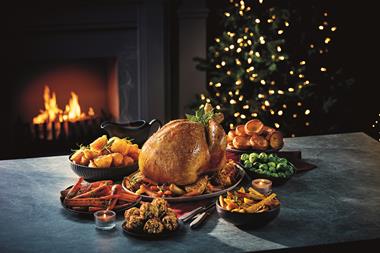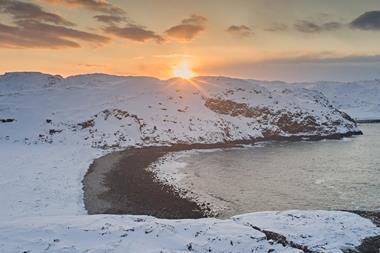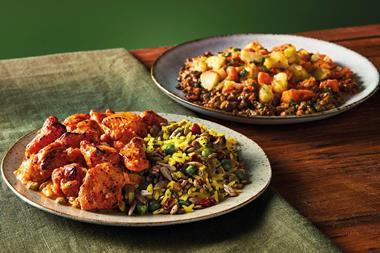ACNielsen's business manager, Gavin Humphreys, says: "There were certainly a lot more deals on offer. Grocers are definitely using liquor to drive sales because it's outperforming all the other categories. Core staple items are at best flat so retailers are looking outside the grocery market to drive footfall, but whether it is actually driving footfall is debatable."
Although beer continues to be a favourite driver of seasonal traffic, the category lost out over Christmas with its share of sales in the total alcohol market decreasing to 23.9% compared to 24.3% in 2001. Humphreys puts this down to unprecedented price cuts at the premium end of the sector where brands normally hold their prices and help balance the deals in standard lager."Despite all the 24-packs of beer on offer, beer had a disappointing Christmas because although there are more premium brands which should keep prices up there was huge discounting in this area," he says.
But some brewers still managed to turn in successful performances. The ubiquitous Stella Artois was once again unfazed by the competition, growing by 26% in the off-trade to £93m. The only beers that beat its growth were Grolsch at 48% and Carlsberg at 75%. Carlsberg reaped the benefits of Somerfield's decision to knock the price of a 24-pack down to a record low of £8.99.
Retailers' aggressive stance on beer caused cider to take a knock with the ailing sector's total sales dropping by 9% to £43m.
The FABs market, on the other hand, managed to reverse the trend of September and October. ACNielsen said it was in decline and slowing dramatically before Christmas. Drinkers took festive sales up 12% to £76m.
But consumer habits in the FABs market were heavily influenced by retailer discounting. Sainsbury was among the most prolific with a three four-packs for £10 deal on Bacardi Breezer.
Sainsbury spirits and PPS buyer Henry Stephenson says: "Archers Aqua suffered it's always going to lose out to Bacardi Breezer which will get the lead deals."
Smirnoff Ice made its first appearance in the top 20 bestselling alcohol brands, its performance undoubtedly bolstered by the introduction of Smirnoff Black Ice, although Stephenson says the newcomer has been a double-edged sword for Diageo. "Black Ice has helped get it more frontage on shelf, but it has eaten into sales of Smirnoff Red Ice, so it hasn't all been incremental growth."
But Diageo will not be disappointed by its strategy in spirits the category with the second largest share of total alcohol sales at 28.8% topped only by wine at 30.2%. Not only did Baileys take second place in the overall top 20 selling alcohol brands with £48m, it also took pole position in spirits."We had Baileys on offer at £12.99 and at that price it's going to fly off the shelves. Tia Lusso (a new entry to the spirits top 20 at number 19) had a very hard task even though it matched Baileys on price," says Stephenson.
The Famous Grouse was another winner with sales up 20% on the back of ads and deep cut price promotions on litre bottles.
Gordon's took a 6% drop on last year, which Stephenson says is a concern. "Gin is a slow category. As Diageo virtually owns the category, it's up to them to do the work to turn it around and I'm not sure the arrival of the Gordon's Edge PPS is it."
Champagne stole a march on all its rival categories by showing the largest percentage increase in sales on last year up a whopping 25% to £67m. Humphreys says: "There was heavy discounting and lots of category deals rather than just across brands."
Tesco's product development manager, Lindsay Talas, says this was reflected in its sales. "We significantly outperformed the market, especially on champagne sales. The biggest success story was undoubtedly the Which? magazine feature which rated Tesco Premier Cru Champagne above Bollinger, Veuve Cliquot and Moët. This generated unprecedented press coverage and customer demand."
Martini Asti Spumante and Bollinger were the only brands in the top 10 champagnes and sparkling wines to lose share. Christmas' winners were Moët & Chandon in first place followed by Lanson.
Light wine (excluding British) continued to be the trade's biggest cash cow, pulling in sales of £628m. Asda's marketing manager for wine, Gareth Roberts, says that Blossom Hill was among the retailer's biggest successes.
"It has great synergies with our core customers. Although we had a few hero deals on other wines, we didn't do limited offers this year as we want to trade on year-round EDLP, " he explains.
Top of the tree was Hardy, which increased its sales by 31% to £39m steaming ahead by four places on last year's figures. Fellow Aussie labels Lindemans and Rosemount also turned in good growth for troubled Southcorp.
Humphreys says: "There was plenty of Australian wine around and promotions were driven by the big brands. Hardy certainly ran some heavyweight promotions."
Tesco's Talas agrees that a 20% reduction in the prices of its Australian brands helped swell sales.
But overall Humphreys doubts that wine discounting was any deeper last Christmas than previous years, despite widespread retailer criticism from suppliers.
Humphreys adds: "Beer saw some of the heaviest discounting along with champagne, but in wine we didn't see particularly more than usual. If I were a brewer I would be worried about the continued rise of wine and the amount of space that's given to it."
{{ANALYSIS }}
Although beer continues to be a favourite driver of seasonal traffic, the category lost out over Christmas with its share of sales in the total alcohol market decreasing to 23.9% compared to 24.3% in 2001. Humphreys puts this down to unprecedented price cuts at the premium end of the sector where brands normally hold their prices and help balance the deals in standard lager."Despite all the 24-packs of beer on offer, beer had a disappointing Christmas because although there are more premium brands which should keep prices up there was huge discounting in this area," he says.
But some brewers still managed to turn in successful performances. The ubiquitous Stella Artois was once again unfazed by the competition, growing by 26% in the off-trade to £93m. The only beers that beat its growth were Grolsch at 48% and Carlsberg at 75%. Carlsberg reaped the benefits of Somerfield's decision to knock the price of a 24-pack down to a record low of £8.99.
Retailers' aggressive stance on beer caused cider to take a knock with the ailing sector's total sales dropping by 9% to £43m.
The FABs market, on the other hand, managed to reverse the trend of September and October. ACNielsen said it was in decline and slowing dramatically before Christmas. Drinkers took festive sales up 12% to £76m.
But consumer habits in the FABs market were heavily influenced by retailer discounting. Sainsbury was among the most prolific with a three four-packs for £10 deal on Bacardi Breezer.
Sainsbury spirits and PPS buyer Henry Stephenson says: "Archers Aqua suffered it's always going to lose out to Bacardi Breezer which will get the lead deals."
Smirnoff Ice made its first appearance in the top 20 bestselling alcohol brands, its performance undoubtedly bolstered by the introduction of Smirnoff Black Ice, although Stephenson says the newcomer has been a double-edged sword for Diageo. "Black Ice has helped get it more frontage on shelf, but it has eaten into sales of Smirnoff Red Ice, so it hasn't all been incremental growth."
But Diageo will not be disappointed by its strategy in spirits the category with the second largest share of total alcohol sales at 28.8% topped only by wine at 30.2%. Not only did Baileys take second place in the overall top 20 selling alcohol brands with £48m, it also took pole position in spirits."We had Baileys on offer at £12.99 and at that price it's going to fly off the shelves. Tia Lusso (a new entry to the spirits top 20 at number 19) had a very hard task even though it matched Baileys on price," says Stephenson.
The Famous Grouse was another winner with sales up 20% on the back of ads and deep cut price promotions on litre bottles.
Gordon's took a 6% drop on last year, which Stephenson says is a concern. "Gin is a slow category. As Diageo virtually owns the category, it's up to them to do the work to turn it around and I'm not sure the arrival of the Gordon's Edge PPS is it."
Champagne stole a march on all its rival categories by showing the largest percentage increase in sales on last year up a whopping 25% to £67m. Humphreys says: "There was heavy discounting and lots of category deals rather than just across brands."
Tesco's product development manager, Lindsay Talas, says this was reflected in its sales. "We significantly outperformed the market, especially on champagne sales. The biggest success story was undoubtedly the Which? magazine feature which rated Tesco Premier Cru Champagne above Bollinger, Veuve Cliquot and Moët. This generated unprecedented press coverage and customer demand."
Martini Asti Spumante and Bollinger were the only brands in the top 10 champagnes and sparkling wines to lose share. Christmas' winners were Moët & Chandon in first place followed by Lanson.
Light wine (excluding British) continued to be the trade's biggest cash cow, pulling in sales of £628m. Asda's marketing manager for wine, Gareth Roberts, says that Blossom Hill was among the retailer's biggest successes.
"It has great synergies with our core customers. Although we had a few hero deals on other wines, we didn't do limited offers this year as we want to trade on year-round EDLP, " he explains.
Top of the tree was Hardy, which increased its sales by 31% to £39m steaming ahead by four places on last year's figures. Fellow Aussie labels Lindemans and Rosemount also turned in good growth for troubled Southcorp.
Humphreys says: "There was plenty of Australian wine around and promotions were driven by the big brands. Hardy certainly ran some heavyweight promotions."
Tesco's Talas agrees that a 20% reduction in the prices of its Australian brands helped swell sales.
But overall Humphreys doubts that wine discounting was any deeper last Christmas than previous years, despite widespread retailer criticism from suppliers.
Humphreys adds: "Beer saw some of the heaviest discounting along with champagne, but in wine we didn't see particularly more than usual. If I were a brewer I would be worried about the continued rise of wine and the amount of space that's given to it."
{{ANALYSIS }}















No comments yet